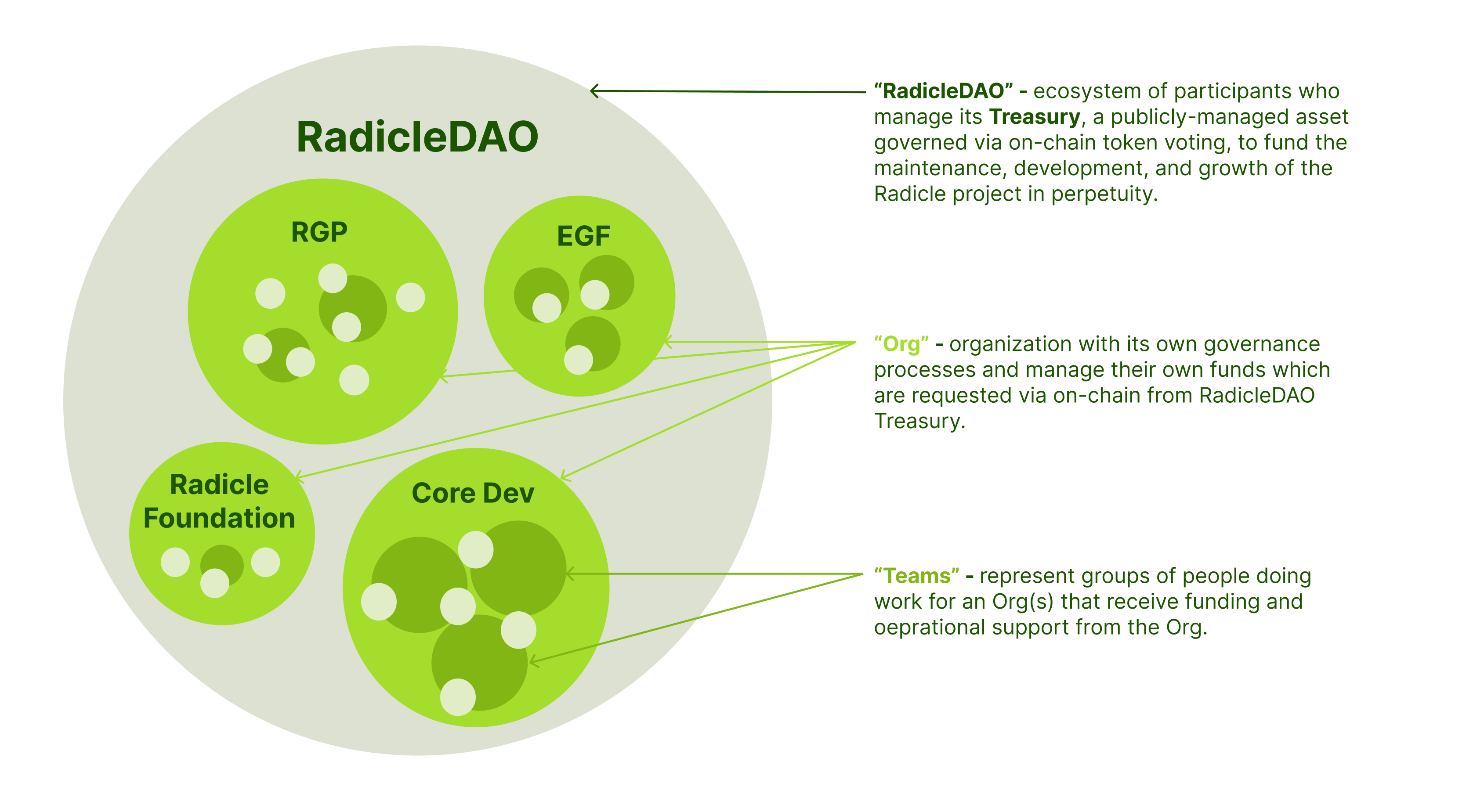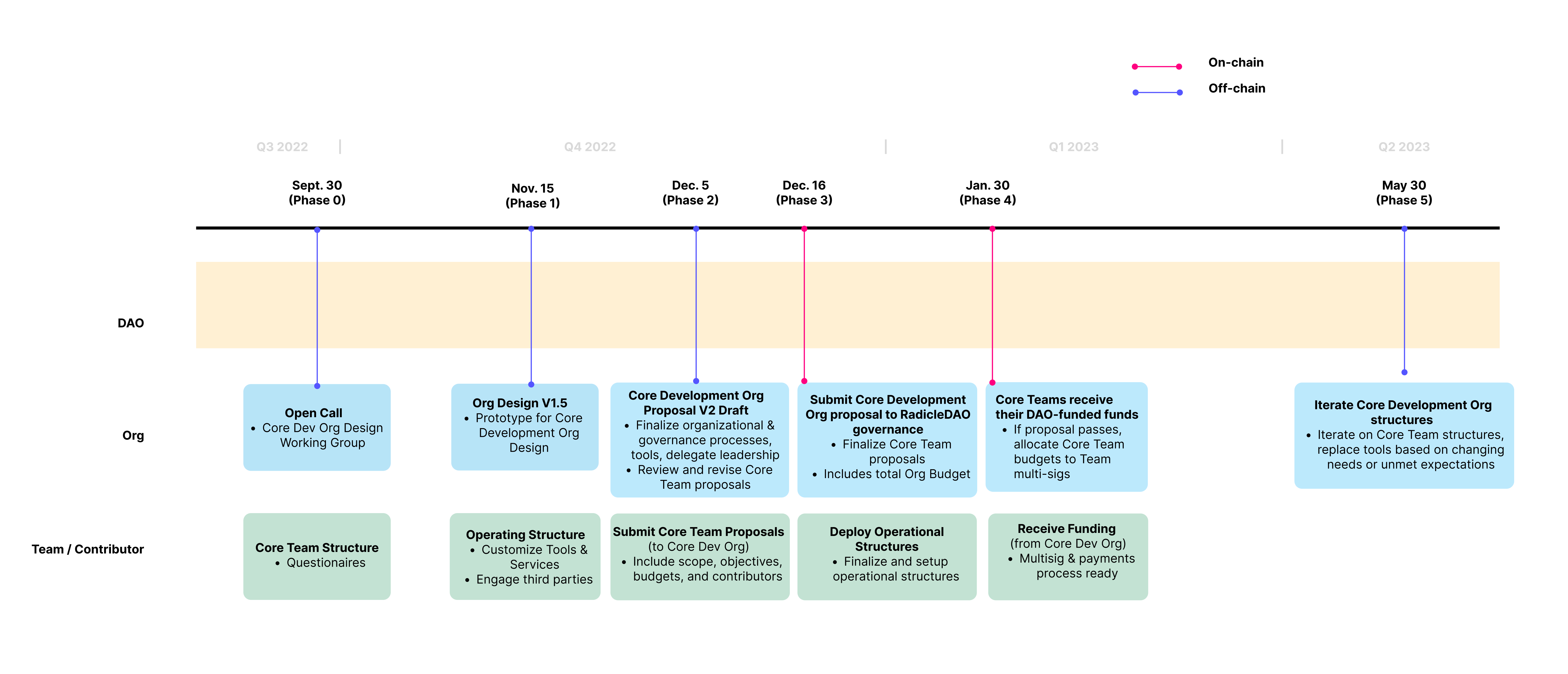TL:DR; In the transition to the DAO, we are moving to an ecosystem model in which multiple Orgs are nestled within the RadicleDAO. The Core Development Org will be the entity that replaces the role of the Foundation Council in coordinating the work of Radicle’s Core Teams. Separating from the Radicle Foundation and formalizing the Core Development Org means opening a new design space for Core Team decision-making & operational processes and new Org level roles with separate responsibilities & incentives. Designing the way this Org works is what the Org Design work stream will be focused on over the next three months.
We’ll discuss this post on a public call this week on Friday, Sept. 16th @ 4pm CET (add to your calendar). We have also published an Open Call for contributors who are interested in helping design the Core Development Org.
Introduction
In an effort to move towards The Path of Increasing Decentralization within Radicle and further reduce the role of the Radicle Foundation, the Org Design Workstream has been on a mission to transition all core development to “the DAO”. In practice, this means developing an organizational framework that could absorb and distribute the responsibilities currently held by the Radicle Foundation related to the onboarding, funding, and coordination of Radicle Core Teams.
Up until now, this work-in-progress design has been coined the “MVDAO” as the first step of the RadicleDAO’s greater evolution. However, this term caused much confusion, as those outside the workstream tried to understand what part of the RadicleDAO we were actually designing.
This post aims to clarify the pieces that make up this “Org Design” and set a more detailed timeline for the work to come with opportunities to get involved.
The RadicleDAO Ecosystem

The RadicleDAO is the term we use to represent the ecosystem of contributors, users, and stakeholders within the Radicle project. The participants of the RadicleDAO manage its Treasury, a publicly-managed asset governed via on-chain token voting. The purpose of the Treasury is to fund the maintenance, development, and growth of the Radicle project in perpetuity.
The RadicleDAO is composed of nested, autonomous, polycentric organizations (“Orgs”). These Orgs are like subDAOs in the sense that they exhibit their own governance processes and manage their own funds. They are, however, funded directly from the Treasury and therefore must have their budget approved by the community via on-chain governance. Orgs are considered trusted actors in the RadicleDAO.
These Orgs fund Teams. Teams could be called pods, spokes, or squads but at their core, they just represent groups of people doing work for an Org(s). Teams themselves can have any management structure. A key point is that they receive their funding directly from Orgs vs. the RadicleDAO Treasury.
The reason for designing the RadicleDAO ecosystem as a network of orgs funding interconnected teams is to distribute power away from pools of centralization that currently exist in an effort to embed resilience and support self-organization. By nesting localized decision-making centers and offering multiple points of power at different scales, the ecosystem can be more adaptable, emergent, and balanced.
To further clarify and prioritize, from here on out, this workstream is focused on the design of the Core Development Org, not at the RadicleDAO level.
Core Development Org
The Core Development Org is an Org (as defined above) that exists within the RadicleDAO.

As an organization, it is responsible for coordinating cross-team strategic work and the necessary direct-to-DAO interactions (e.g. on-chain governance proposals) for Radicle core development. “Core development” includes the setting of project vision & strategy, as well as the maintenance and development of the Radicle stack currently done by Core Teams (e.g. Community & Governance, Funding, Clients) and their contributors.
Within the Org, Core Teams each act as a trusted, self-managed Team (as defined above). They manage their own budgets, contributor payouts, and contracts, but they align around a shared set of organizational and technical principles. Core Teams are onboarded/offboarded to the Org based on a standardized set of criteria.
This Org does not include the work of existing DAO-funded initiatives such as the Radicle Grants Program and Ecosystem Growth Fund. They can be considered separate Orgs, that may share Teams with the Core Development Org.
The Core Development Org will absorb some responsibilities currently handled by the Foundation and its Council (see next section). It also requires funding from the Treasury for Core Team budgets via an on-chain proposal.
Distribution of Responsibilities
- Org level — Responsibilities assumed by the decision-making group(s) spawned within the Org
- Philosophy — Setting the vision, mission, general philosophy for guiding core development
- Membership — Managing the members of the organization
- New Teams — Defining and managing the onboarding process for new Core Teams
- Existing Teams — Holding Core Teams accountable and enabling their continued work.
- Offboarding Teams — Defining and managing the offboarding process for Core Teams
- Treasury Funding — Coordinating community approval for Core Team budgets
- Team level — Responsibilities assumed by individual Core Teams
- Operating Structure** (see definition below) - Creation and maintenance of operational structure
- Contributor contracts — Issuing and managing contracts for contributors
- Contributor payments — Paying contributors
- Hiring — Coordinating hiring priorities avenues, contacts, etc for hiring new team-members
- Budgeting — Creating and managing team budgets, coordinating approval with Org
- Cross-Team coordination — how to think about coordination across teams
- Operating Structure** (see definition below) - Creation and maintenance of operational structure
Designing the Core Development Org
As the Core Development Org and Radicle Foundation separate into two different orgs, this is an opportunity to design new decision-making & operational processes and propose a new “leadership” structure. This “blueprint” of how the Core Development Org works will come with a new set of roles that will have to be filled. We hope to find out the scope of these roles (responsibility, time commitment, incentive) through a collaborative design process, via a Working Group Open Call for contributors.
Onboarding Core Teams
At this stage, the responsibility of managing contributor contracts & payments and coordinating budgets will lie with the Core Team themselves. This means each Core Team will be responsible for implementing an operational structure that best fits the needs of their contributors.
While the concept of managing an operational structure can seem intimidating, the types of structures can vary greatly depending on the needs of a Core Team. They could be anything from a simple multisig to an established legal entity. The Org Design workstream is currently building relationships with third-party service providers like AccountAble (see this video overview), Skyline Digital, and WorkDAO so when core teams understand the needs of their contributors and which operational structure, we are able to make the right connections.
Because of this, contributors are responsible for understanding & communicating their personal tax needs to their respective Core Teams so the Core Teams can choose the most appropriate operational structure for their contributors. We will be providing guidance and materials to individuals and Core Teams to navigate this process
What happens to the Foundation?
The Radicle Foundation will continue to exist as a separate Org with minimized responsibilities outside of day to day Core Development work. It will also require on-chain approval for funding.
Transition Phases
Now that we’ve defined the scope of the Core Development Org, we must get there somehow! Here’s how we — the Org Design team — see us making this transition over the course of the sixth months. The deliverables are categorized by who’s responsible/required to contribute (e.g. DAO, Org, Team/Individual) and what type of governance is required (on-chain, off-chain).

[Phase 0] - 30 September 2022
Outcome: Support Core Teams form their structure by helping them understand how they will organize within the Core Development Org. Start co-designing design of org with interested contributors
- [TEAM] Complete the Core Team Discussion Questions (Team & Operations Structure)[COMING SOON]
- [TEAM & INDIVIDUAL] Utilize the Contributor Tax/DAO Planner Questionnaire [COMING SOON]
- [ORG] Open Call for Working Group Contributors
[Phase 1] - 15 November 2022
Outcome: Develop Core Development Organization and Core Team Prototypes
- [TEAM] Customize tooling and services stack, based on desired operational structure
- [TEAM & INDIVIDUAL] Start establishing relationships with third parties for desired contributor services (e.g. employers of record, legal entities)
- [ORG] Finalize Radicle Vision/Mission
- [ORG] Converge on organizational model proposals. Create a blueprint for Core Development Org V2 Design
[Phase 2] - 5 December 2022
Outcome: Create draft for Core Development Org proposal
- [TEAM] Create draft of Core Team off-chain proposal for design of the Core Development Org including scope, objectives, budgets, and contributors
- [ORG] Review and revise Core Team proposals
- [ORG] Finalize organizational & governance processes, tools, delegate leadership
[Phase 3] - 16 December 2022
Outcome: Finalize Core Development Org proposal and submit it to RadicleDAO governance
- [TEAM] Finalize and deploy operational structures
- [ORG] Finalize Core Team proposals
- [ORG] Submit Org proposal (including budget) to the RadicleDAO and start navigating the governance process
[Phase 4] - 30 January 2023
Outcome: Core Teams receive their DAO-funded funds
- [ORG] If proposal passes, allocate Core Team budgets to Team multi-sigs
[Phase 5] - 30 May 2023 and ONGOING
Outcome: Iterate Core Development Org structures
- [ORG] Iterate on Core Team structures, replace tools based on changing needs or unmet expectations
These timelines and outcomes are subject to change, but represent a more discrete overview of the milestones that lie on the transition path to the DAO.
We’ll be answering questions and discussing this post in detail on Friday, Sept. 16th @ 4pm (add to your calendar).